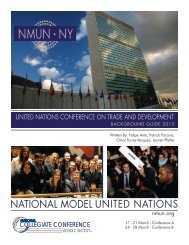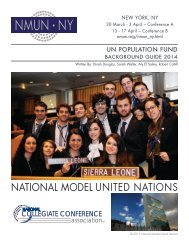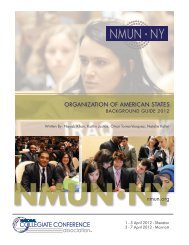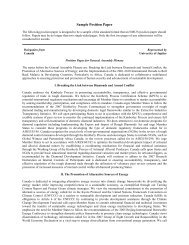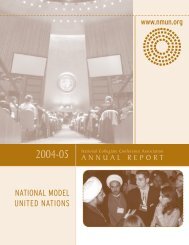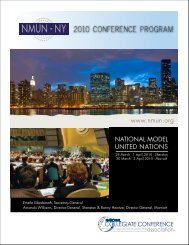NMUN • KOREA - National Model United Nations
NMUN • KOREA - National Model United Nations
NMUN • KOREA - National Model United Nations
Create successful ePaper yourself
Turn your PDF publications into a flip-book with our unique Google optimized e-Paper software.
not fully integrated in any department or program. 11 The UNFCCC is a multilateral environmental treaty and is as<br />
such connected to, but not identical with the UN system. The Secretariat is independent, but linked to the UN’s<br />
institutional infrastructure; the UN Secretary-General can appoint the UNFCCC Executive Secretary in consultation<br />
with the Bureau of the UNFCCC. 12 The current UNFCCC Executive Secretary is Christiana Figueres from Costa<br />
Rica. 13<br />
The UNFCCC´s work is supported by the Intergovernmental Panel on Climate Change (IPCC), which was<br />
established in 1988 and is institutionally independent of the UNFCCC. The IPCC is an expert body that “reviews<br />
and assesses […) the most recent scientific, technical and socioeconomic information produced worldwide” and<br />
functions as an advisory body to the COP. 14 Key findings are regularly reported in major Assessment Reports, of<br />
which the fifth edition is due in 2014. Another supportive mechanism is the Green Climate Fund (GCF), which<br />
serves as the operating vehicle of the financial transfer provisions set out in the Convention. While the GCF was<br />
brought to life by the UNFCCC COP, it is governed by a separate GCF Board and its headquarters are currently<br />
being established in Songdo, Republic of Korea.<br />
The Kyoto Protocol and current developments in the international architecture on climate change<br />
In 1995, the Parties decided to formulate strengthened commitments and to make the Convention more operational.<br />
The resulting Kyoto Protocol was adopted in 1997 as an adjunct, but separate agreement that bindingly commits<br />
industrialized countries to stabilize harmful greenhouse gas emissions, whereas the 1992 Convention merely<br />
encouraged them to do so. 15 The Kyoto Protocol sets specific and measurable reduction targets for the GHG<br />
emissions of 37 industrialized (Annex B) countries, including the European Union, within a first period of<br />
commitment and based on 1990 levels. 16 The Protocol entered into force in 2005, after all ratification criteria were<br />
met, and has currently 192 parties. 17<br />
The Kyoto Protocol was the first international instrument within the UNFCCC framework that legally bound<br />
countries to reduce the emissions of six major greenhouse gases within the years 2005-2012. 18 While the Annex B<br />
countries are supposed to meet their targets with domestic adaptations of their economies, they can also make use of<br />
new instruments to encourage GHG reductions where they can be realized most cost-efficiently. 19 For this, the<br />
Kyoto Protocol introduced three innovative, market-based mechanisms:<br />
(1) International Emissions Trading, which allows countries with spare emission units “to sell this excess<br />
capacity to countries that are over their targets.” 20<br />
(2) The Clean Development Mechanism (CDM), which allows Annex B countries to “implement an emissionreduction<br />
project in developing countries” in order to obtain “saleable certified emission reduction (CER)<br />
credits” which can be counted in their national emission reduction targets. 21<br />
(3) Joint Implementation (JI), which allows Annex B countries to count “emission-reduction or emission<br />
removal” projects in other Annex B countries towards their national Kyoto target. 22<br />
The Kyoto Protocol is seen as a significant step to realize an effective international regime to reduce GHG<br />
emissions. 23 Its major weaknesses, though, were that it did not reach universal ratification (e.g. lacking the<br />
ratification of the <strong>United</strong> States); that major industrialized economies agreed only to modest targets; and that major<br />
11 New Zealand Ministry of Foreign Affairs, <strong>United</strong> <strong>Nations</strong> Handbook 2012/2013, 2013, p. 307.<br />
12 UNFCCC Conference of Parties, Decision 14/CP.1. In: UNFCCC Conference of Parties, Report on its First Session, 1995.<br />
13 UNFCCC. Executive Secretary, 2013.<br />
14 UNFCCC, Intergovernmental Panel on Climate Change (IPCC), 2013.<br />
15 UNFCCC, Making those first steps count, 2013.<br />
16 Kyoto Protocol to the <strong>United</strong> <strong>Nations</strong> Framework Convention on Climate Change, 1998.<br />
17 UNFCCC, Making those first steps count, 2013.<br />
18 The greenhouse gases are: Carbon dioxide (C02) ; Methane (CH4); Nitrous oxide (N20); Hydrofluorocarbons (HFCs);<br />
Perfluorocarbons (PFCs); and Sulphur hexafluoride (SF6). Kyoto Protocol, 1998, Annex A.<br />
19 UNFCCC, Making those first steps count, 2013.<br />
20 UNFCCC, International Emissions Trading, 2013.<br />
21 UNFCCC, Clean Development Mechanism (CDM), 2013.<br />
22 UNFCCC, Joint Implementation (JI), 2013.<br />
23 Stern, Review on The Economics of Climate Change, 2007, pp. 541-543.



